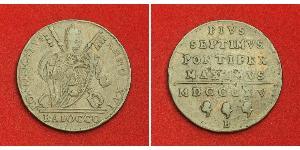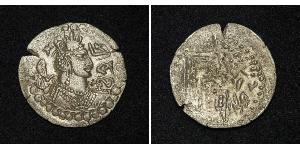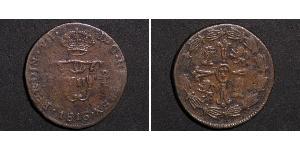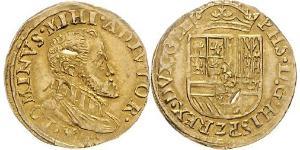(sold for $14.0)
Byzantine Empire, Justinian I (527-565 AD) Large Bronze 40 Nummi Coin. F+
Denomination: 40 Nummi
Mint period: 539-540 AD
Mint Place: Constantinople
Emperor: Justinian I (527-565)
Condition: Corrosion scars, otherwise F+
Reference: DOC 38e, MIBE 95a, Sear 163.
Material: Bronze
Diameter: 40mm
Weight: 20.7gm
Obverse: Cuirassed bust of Justinian I facing, wearing crested helmet with pearl diadem over trefoil ornament and pendilia, holding globus cruciger and shield, cross in right field.
Reverse: Mark of value M (=40), officina letter (€) within, cross above, regnal year (ANNO - XIII = Year 13) at sides. Mint name (CON for Constantinople) in exergue.
In Eastern Christianity, the most widely used Christogram is a four-letter abbreviation, ΙϹ ΧϹ — a traditional abbreviation of the Greek words for "Jesus Christ" (i.e., the first and last letters of each of the words "ΙΗϹΟΥϹ ΧΡΙϹΤΟϹ, with the lunate sigma "Ϲ" common in medieval Greek), and written with titlo (diacritic) denoting scribal abbreviation (І҃С Х҃С). On icons, this Christogram may be split: "ΙϹ" on the left of the image and "ΧϹ" on the right. It is sometimes rendered as "ΙϹ ΧϹ ΝΙΚΑ", meaning "Jesus Christ Conquers." "ΙϹΧϹ" may also be seen inscribed on the Ichthys. In the traditional icon of Christ Pantokrator, Christ's right hand is shown in a pose where his fingers bend and cross to form the letters ΙϹ, Χ, and Ϲ.
John II Komnenos or Comnenus (Ioannes II Komnenos) (September 13, 1087 – April 8, 1143) was Byzantine emperor from 1118 to 1143. Also known as Kaloïoannes ("John the Beautiful"), he was the eldest son of emperor Alexios I Komnenos and Irene Doukaina. The second emperor of the Komnenian restoration of the Byzantine Empire, John was a pious and dedicated emperor who was determined to undo the damage his empire had suffered at the battle of Manzikert, half a century earlier.
In the course of his twenty-five year reign, John made alliances with the Holy Roman Empire in the west, decisively defeated the Pechenegs in the Balkans, and personally led numerous campaigns against the Turks in Asia Minor. John's campaigns fundamentally changed the balance of power in the east, forcing the Turks onto the defensive and restoring to the Byzantines many towns, fortresses and cities right across the peninsula. In the southeast, John extended Byzantine control from the Maeander in the west all the way to Cilicia and Tarsus in the east. In an effort to demonstrate the Byzantine emperor's role as the leader of the Christian world, John marched into the Holy Land at the head of the combined forces of Byzantium and the Crusader states; yet despite the great vigour with which he pressed the campaign, John's hopes were disappointed by the treachery of his Crusader allies, who deliberately failed to fight against the Muslim enemy at the crucial moment. Also under John, the empire's population recovered to about 10 million people.
The Latin historian William of Tyre described John as short and unusually ugly, with eyes, hair and complexion so dark he was known as 'the Moor'. Yet despite his physical appearance, John was known as Kaloïoannes, "John the Handsome" or "John the Beautiful". The epithet referred not to his body but to his soul. Both his parents had been unusually pious and John surpassed them. Members of his court were expected to restrict their conversation to serious subjects only. The food served at the emperor's table was very frugal and John lectured courtiers who lived in excessive luxury. Despite his austerity, John was loved. His principles were sincerely held and his integrity great.
John was famed for his piety and his remarkably mild and just reign. He is an exceptional example of a moral ruler, at a time when cruelty was the norm. He never condemned anyone to death or mutilation. Charity was dispensed lavishly. For this reason, he has been called the Byzantine Marcus Aurelius. By the personal purity and piety of his character he effected a notable improvement in the manners of his age. Gifted with great self control and personal courage, John was an excellent strategist and an expert imperator in the field, and through his many campaigns he devoted himself to the preservation of his empire.
John II Komnenos left the empire a great deal better off than he had found it. Substantial territories had been recovered, and his successes against the invading Pechenegs, Serbians and Seljuk Turks, along with his attempts to establish Byzantine suzerainty over the Crusader States in Antioch and Edessa, did much to restore the reputation of his empire. His careful, methodical approach to warfare had protected the empire from the risk of sudden defeats, while his determination and skill had allowed him to rack up a long list of successful sieges and assaults against enemy strongholds. By the time of his death he had earned near universal respect, even from the Crusaders, for his courage, dedication and piety. His early death meant his work went unfinished — his last campaign might well have resulted in real gains for Byzantium and the Christian cause.

|
Posted by:
anonymous 2016-10-21 |
Cent USA (1776 - ) Tin/Copper/Zinc
group has 42 coins / 26 prices
⇑
1 Krone Austria-Hungary (1867-1918) Silver Franz Joseph I (1 ...
group has 16 coins / 14 prices
⇑















-300-150-UXAKbzbi6GoAAAFLHB9KKMPB.jpg)

-300-150-yTrBwcI0z7EAAAEmG8UxGksz.jpg)






